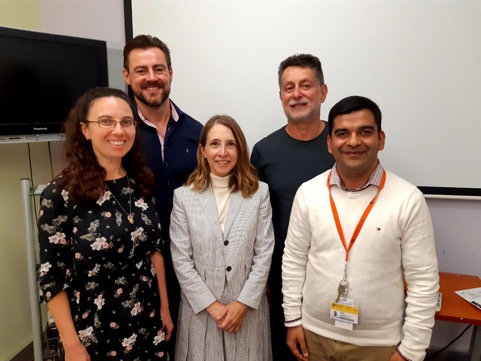Save Sight Keratoconus Registry Updates

November 2023
Watch the latest update from the Save Sight Keratoconus Registry
July 2019
Sight Keratoconus Registry Committee focuses on patient outcomes
The advisory committee of the Save Sight Keratoconus Registry (SSKR) met on the 20th May 2019. The SSKR is part of the Fight Corneal Blindness! Project. Members including Mr Larry Kornhauser from Keratoconus Australia, Dr Laura Downie and A/Prof Gregory Harper from the University of Melbourne, and representatives from the Therapeutic Goods Administration and Save Sight Registries team, focussed on ensuring the registry met patient needs during the meeting.
Professor Stephanie Watson, Chief Investigator for the SSKR provided an update on the registry. The SSKR is a growing multinational database tool that enables eye-carers to track the outcomes of patients with keratoconus, including patient reported outcomes. It is a world first, as it collects data from everyday practice to learn more about keratoconus and improve its treatment.
Currently, the SSKR has 68 users (doctors) from 65 sites in Australia, New Zealand, Spain, Italy, France and Switzerland. The registry consists of data from more than 20,000 visits for 4,200 eyes of 2,300 patients. It is an extremely useful tool for monitoring patient outcomes, clinical events, adverse events, and for conducting research and educating patients. To find out more visit https://www.keratoconus.org.au/treatments/australian-crosslinking-registry/

Talented researcher joins Save Sight Registry team
Dr Himal Kandel joined the SSKR as a Kornhauser Research associate in January 2019. His full time-position for three years is funded by the Kornhauser fellowship, a philanthropic donation from Mr Larry Kornhauser – the president of the Keratoconus Australia. Dr Kandel has completed his PhD from Flinders University, Adelaide on measuring quality-of-life impact of eye diseases. He has received several awards including the Vice-Chancellor’s Prize for Doctoral Thesis Excellence, the South Australian International Student of the Year, and the South Australian Academic Excellence Award – Postgraduate research category. Dr Kandel has published his work in several scientific journals and presented at several national and international conferences, including the Association for Research in Vision and Ophthalmology (ARVO) annual meetings. He has been selected to present his work on quality-of-life impact of keratoconus at the 10th EUCornea Congress, Paris in September 2019.
Research updates: What is new in keratoconus?
Dr Alex Ferdi, PhD student, looked through 4,000 studies and combined the data from 41 of these to find out about the natural course of keratoconus. Children under 17 years old and people with steeply shaped eyes were at higher risk of their disease worsening over a year.
“It was surprising how little modern research has been done investigating what happens to keratoconus over a lifetime” said Dr. Ferdi. “Yet knowing this is crucial in evaluating if patients need procedures such as corneal cross-linking”.
Dr Ferdi also found that Middle Eastern patients are at higher risk of progression than Europeans or East Asians.
Dr. Ferdi advised ophthalmologists to keep in mind age, corneal curvature, and background when evaluating progression risk, and the risks and benefits of cross-linking.

However, much remains unknown on what happens to patients with keratoconus in the long term, what treatments they need, how they respond to treatment, and the benefit to the patient of treatment. The answer to these questions can come from ‘real world data’. That is information from medical practice that has in the past not been collected or analysed. With the SSKR we are now able to learn from everyday practice. Patients should ask their optometrist and/or ophthalmologist register them on the SSKR (https://frb-research.org).
“Our study has demonstrated the urgent need to log more data from people with keratoconus, so we can better understand not only the natural history, but also how people respond after cross-linking” Dr Ferdi said.
First prize was awarded to Dr Ferdi at the Annual Save Sight Institute, The University of Sydney Higher Degree Research Symposium for his presentation on this work.
The links to the recently published papers from the SSKR team are provided here: Natural history of keratoconus, Vision related quality of life in keratoconus, Registries in Ophthalmology, and Outcomes of cross-linking.
Optometry joins the Save Sight Keratoconus Registry
One of the most exciting news about the SSKR is that it will soon be available to optometrists. This will enable optometrists to track the outcomes of keratoconus patients collecting more information regarding the optometric care including the contact lens-related parameters. The optometrists and ophthalmologists will be able to refer patient data to each through the registry system.

25 November 2017
The head of the Save Sight Keratoconus Registry, Professor Stephanie Watson, presented the latest results from the registry on crosslinking at meetings in Melbourne and Sydney in late 2017.
The full video of her presentation at the Keratoconus Australia seminar held in Melbourne in late October 2017 can be viewed here
Professor Watson presented a similar talk to the Kera Club in early November 2017. The Kera Club is a joint Keratoconus Australia- Save Sight Institute initiative to support people with keratoconus in NSW.
The video of the Sydney KeraClub presentations can be found here
Her slideshow presentation can be downloaded here in .pdf format
